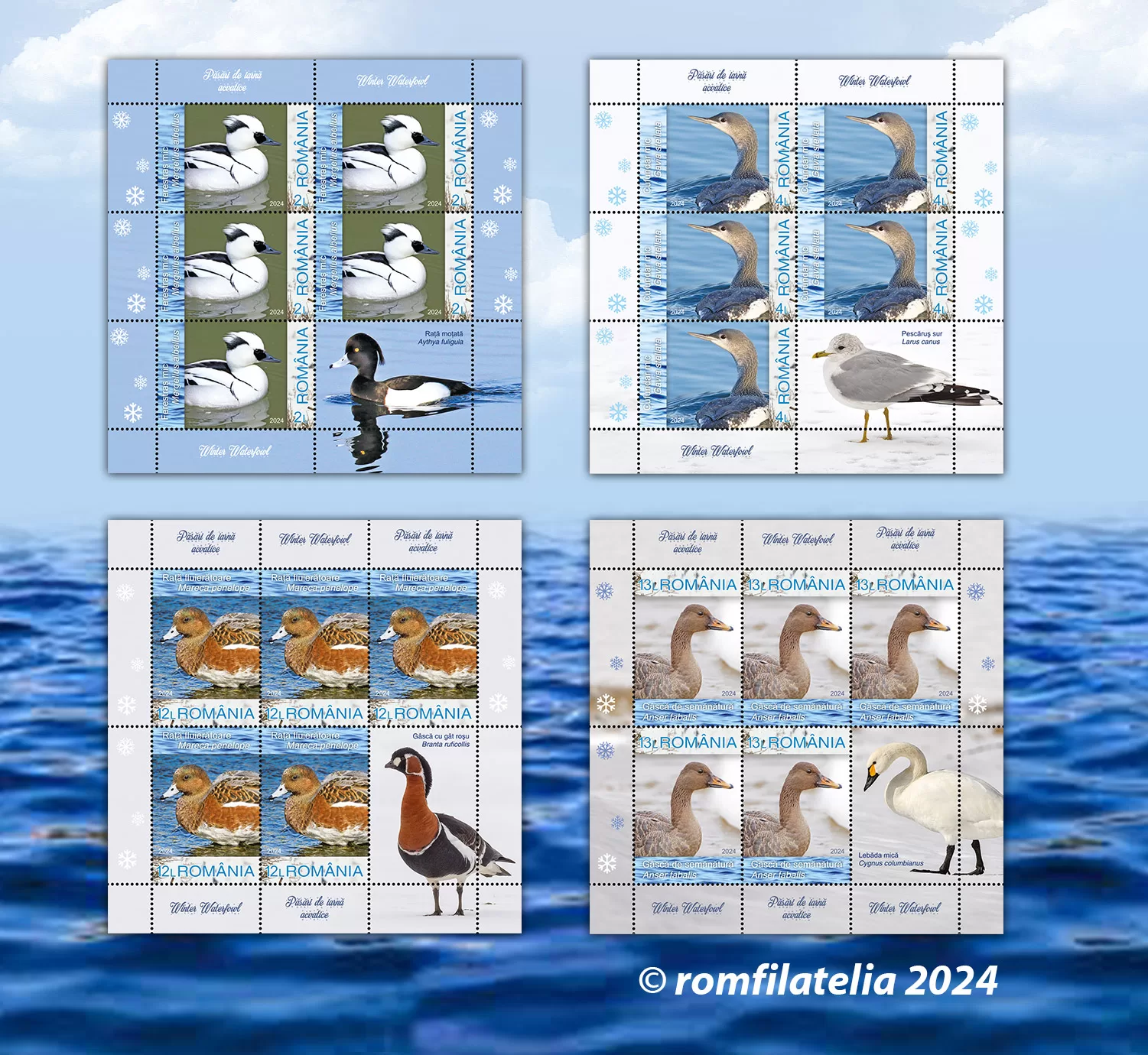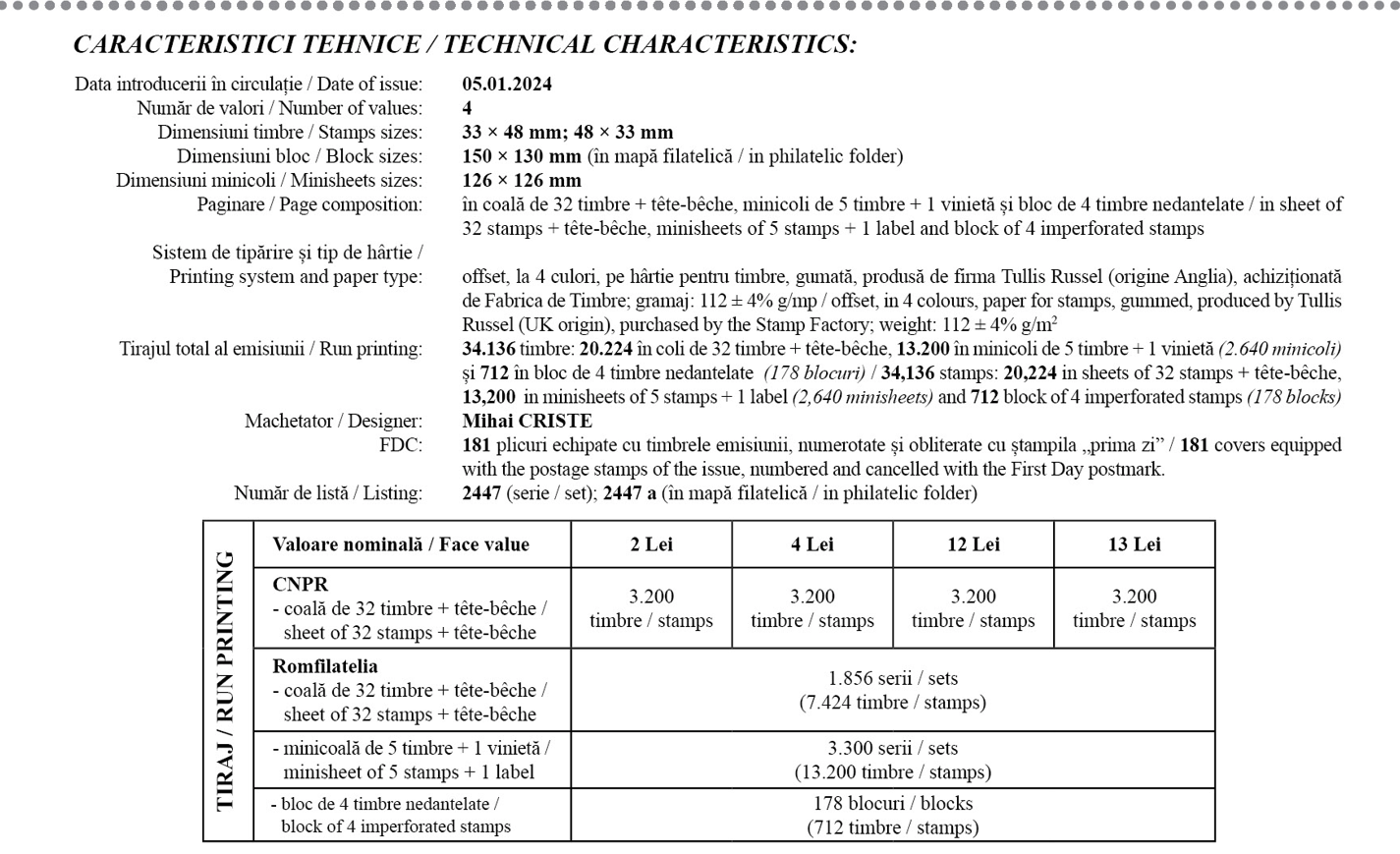 Romfilatelia offers collectors and the public, a new postage stamps issue with the Fauna theme under the general title „Winter Waterfowl”, composed of four stamps, a First Day Cover and a philatelic folder in a limited edition. The issue will be introduced into circulation on Friday, January 5, 2024.
Romfilatelia offers collectors and the public, a new postage stamps issue with the Fauna theme under the general title „Winter Waterfowl”, composed of four stamps, a First Day Cover and a philatelic folder in a limited edition. The issue will be introduced into circulation on Friday, January 5, 2024.
The winter birds, whose images are reproduced on the stamps of the issue, belong, according to the classification of biologists, to the family of homeotherms, whose species have the ability to maintain a constant body temperature, regardless of the season.
The smew (Mergellus albellus), illustrated on the stamp with the face value of Lei 2, it is a species of waterfowl related to ducks, geese and swans that lives in the taiga freshwater areas of northern Europe and Asia. In Romania, during the passage and wintering period, the species can be noticed on most lakes and large rivers, from the plain to the low mountain area. Occasionally, nesting pairs have been noticed in the Danube Delta.
The smew reaches 38 – 44 cm in length, 500 – 900 g in weight and has a wingspan of 56 – 69 cm.
The smew is not a threatened species, but habitat loss and water pollution can have a negative impact on local populations.
The red-throated loon (Gavia stellata), depicted on the stamp with the face value of Lei 4, it is a species of waterfowl that lives and nests in tundra, coastal and lake areas, around the northern regions of Europe. Some specimens also reach Romania during this migration.
The body length is 55- 67 cm, the average weight is 1 – 2.5 kg and the wingspan is 91 – 110 cm.
The red-throated loons reach sexual maturity relatively late, around the age of 3-4 years and can live up to about 20 years.
The Eurasian wigeon (Mareca penelope), illustrated on the stamp with the face value of Lei 12, it is a species that breeds in Northern Europe and Asia and migrates for winter over very long distances. The species can appear in Romania during migration, both in autumn and spring.
Males have chestnut-coloured head and neck plumage, with a brownish-yellowish forehead and pinkish breast, while females are more discreet, predominantly brown. In winter, the males have a much duller plumage, similar to that of females. The body length is 45 – 51 cm, the weight is 600 – 1,000 g in the case of the male and 500 – 800 g in the case of the female, and the wingspan is 75 – 86 cm.
The bean goose (Anser fabalis), represented on the stamp with the face value of Lei 13, it is a species with a widespread in Eurasia, breeding in northern Europe as well as in Siberia. In Romania, it is a rare species.
The species does not exhibit sexual dimorphism, with males and females having similar plumage. The body length is 71 – 89 cm, the average body weight is 3.4 kg (male) and 2.8 kg (female), and the wingspan is 135- 163 cm.
The whistling swan or tundra swan (Cygnus columbianus), illustrated on the First Day Cover, it is a species that lives in the tundra regions of the northern hemisphere, in the form of two subspecies, Cygnus columbianus columbianus (in North America) and Cygnus columbianus bewickii (in Eurasia). The subspecies C. c. bewickii appears in Romania as a winter guest, being especially widespread in the regions of the south-east of the country (Dobrogea, Bărăgan). The subspecies was named after the English naturalist Thomas Bewick.
Romfilatelia thanks Senior Researcher Luis Ovidiu Popa, General Manager of the “Grigore Antipa” National Museum of Natural History, for the documentary consultancy granted to the development of this issue of postage stamps.



